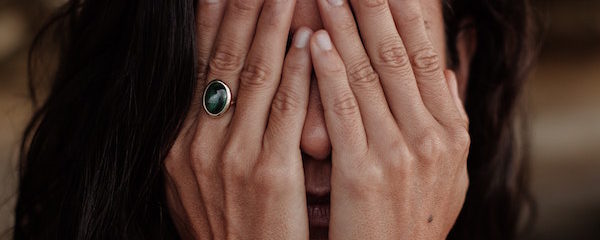Is My Body Jewelry Moving? A Beginner’s Guide to Piercing Rejection July 22, 2020 – Posted in: Informative, Piercing Advice – Tags: avoiding jewelry rejection, body piercing, body piercing advice, body piercing aftercare, jewelry migration, jewelry rejection, piercing rejection, piercing rejection scars, treatment for jewelry rejection
Piercing rejection highlights:
- Piercing jewelry may reject for a number of reasons.
- The best way to avoid rejection is to avoid snags or tears and wear properly-sized jewelry.
- If your piercing starts to reject, it must be retired to avoid substantial scarring.
You’ve gotten a new piercing, you’re adhering to a proper aftercare regimen, and healing seems to be going smoothly. One day, you notice that the skin around your piercing has turned red, and it doesn’t look like your jewelry is in quite the same spot as it was before. What’s going on?
Piercing rejection is a symptom of your body’s natural healing process. Your body’s job is to protect you from foreign entities that can harm you, and it views your jewelry as one of those entities. Once your body has labeled your new jewelry as an enemy that needs to be removed, it will begin the process of pushing your jewelry out, much like it would with an embedded splinter.
You can’t blame your body for jewelry rejection; after all, it’s just doing its job and trying to keep you healthy. Before your body starts rejecting your jewelry, you need to make certain choices to ensure that your body loves your new jewelry as much as you do.
Here’s a brief rundown on jewelry rejection, how to avoid it, and what to do if it happens.

Photo by Philip Martin on Unsplash
What triggers piercing rejection?
Jewelry rejection occurs when your body detects something that shouldn’t be there. Since the jewelry itself is a foreign object that your body will naturally want to remove, sometimes rejection occurs even if you do everything right.
However, there are certain things that are shown to cause jewelry rejection:
- Exposure to certain products during healing, like lotions, tea tree oil, or face wash
- Jewelry that pulls at the piercing holes, such as dangle jewelry or jewelry that’s too large
- Snagged jewelry or other trauma caused to the piercing site
- Cheap alloys that irritate the skin
- Improperly placed piercings (usually surface piercings that were pierced too shallowly)
- Moving the jewelry too much
While most of these triggers occur during the healing period, rejection can occur at any time, so it’s important that you keep an eye on your piercing as long as you have it.
How do I avoid jewelry rejection?
Simply, you must avoid the above triggers of piercing rejection.
A big reason why it’s so important to listen to your piercer when it comes to your starter jewelry is to avoid jewelry rejection. Choose jewelry that’s the proper shape and size so that it won’t harm the piercing.
Much of the success of your piercing will depend upon the expertise of your piercer. This is why it’s so important to do your due diligence and research a high-quality piercer. They will be able to help you choose the best starter jewelry, they’ll conduct the piercing properly, and they’ll give you all of the tips that you need to be successful. Read our guide to finding a reputable piercer here.
Once you’ve been pierced, it’s up to you to maintain the practices that give you the best chance of success. Use only all-natural aftercare products that won’t irritate your piercing. Protect your jewelry from your clothing, hair, and other objects that can snag and damage your new piercing. Keep harmful chemicals well away from your healing piercing, and if you accidentally get soap or shampoo on the piercing as you shower, make sure that you fully rinse the area. Avoid sleeping directly on your healing piercing. Any large amount of pressure can deeply affect the healing of your new piercing.
Signs of piercing rejection
If you ignore the signs of piercing rejection and allow it to progress, you could risk visible scarring. It’s important, therefore, to know when your jewelry is migrating so that you can remove your jewelry and talk to your piercer.
Your body might be rejecting your jewelry if…
- The jewelry has moved
- The skin above the jewelry is becoming thinner
- The piercing points are becoming red and flaky
- The piercing points are becoming bigger
- The jewelry doesn’t fit snugly anymore
It’s important to note that small scars are a risk in any piercing. Once you retire your piercing, no matter how far along it is in its rejection journey, you are likely to see a small permanent mark. By retiring the jewelry at the beginning of the rejection process, you minimize these marks.
How to stop jewelry rejection
Unfortunately, when you see the signs of piercing rejection, it’s often too late to do anything to stop it. Talk to your piercer ASAP. They will let you know what to do and likely remove your jewelry so that you can heal and try again when it is safe to do so.

Photo by Carlos Román Ruíz Basulto on Unsplash
Which piercings are rejected the most?
All piercings can see jewelry rejection. But, some are more prone to rejection than others.
Surface piercings are commonly rejected. This is because surface piercings pierce flat areas of skin, and if it’s not pierced deeply enough, the body can easily push out the jewelry, like it does with a splinter.
Eyebrow piercings are especially prone to rejection. If the piercing is not placed in appropriate tissue, this is especially true. These piercings are also sensitive to accidental jewelry snags. When this happens, an eyebrow piercing can experience rejection even if it is decades old.
Belly button piercings are also no stranger to rejection. The fleshier skin makes for easy jewelry movement, and the location on the belly means that jewelry can be easily snagged and jolted. Although rejection usually happens during healing, rejection can happen in belly piercings that are years old, especially if you become pregnant.
Although jewelry rejection is more common in the above piercing types, and it most often occurs during healing, it can happen in any piercing type at any time, so keep an eye on your piercing throughout its life to watch for signs of rejection and migration.
Jewelry rejection is a real bummer, especially if you’ve worked hard to maintain great aftercare practices. However, it’s not the end of the world. In terms of piercing complications, rejection likely won’t prevent you from re-piercing in the future. Pay attention, and as long as you catch it early enough, you shouldn’t see much scarring. The biggest setback will be to your wallet since you’ll have to get re-pierced.








